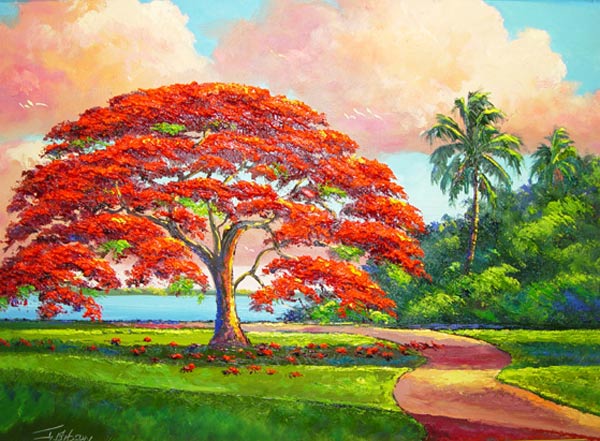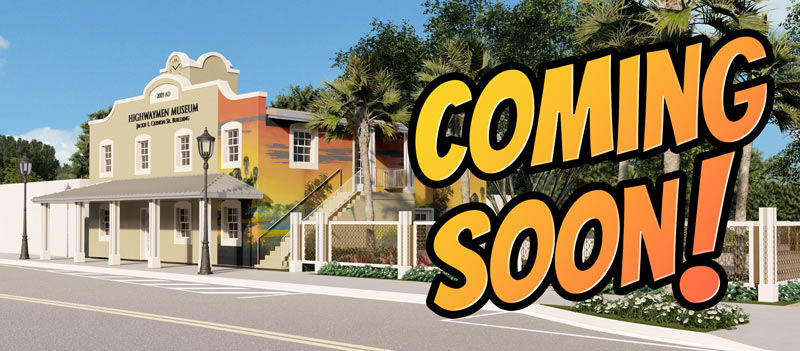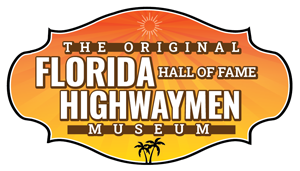About The Original Florida Highwaymen Artists
by Gary Monroe
By painting fast the Highwaymen stripped away the artifice that had characterized conventional American landscape painting, reducing their renditions to the barest essentials. This resulted in fresh and distinctive imagery. This distinction was unintentional because they painted primarily to make money; by saving time and through repetition, they arrived at archetypal scenes. Generally sketchy and suggestive, their paintings differed meaningfully from popular landscape representation, whose roots extended back a hundred years to the Hudson River school of art.
Their artwork functioned differently too because of the way it invested viewers. Buyers of their images were not detached admirers of another’s skill or vision. There was not the sense of looking over someone's shoulder to behold a promised land that was too sacred a place to be homesteaded by them. Each painting was calibrated perfectly for those people making Florida their new home. The land was seen at ground level as if one were standing right there, so viewers could seemingly walk into that very realistic space. Once emotionally invested in these paintings they monetarily invested in the Highwaymen's creations.
These new Floridians, in the afterglow of the Eisenhower years, may have bought their piece of Paradise through a magazine advertisement while they were stuck in their homes in the northeast during a blizzard. Once here, they may have been a tad disappointed by the small builder’s lots that they had been paying off monthly for years in anticipation of coming to Florida. These building sites were nowhere near the ocean and had no palms blowing in the gentle breeze. It was hot and humid here, their new homes were non air-conditioned, and things called cockroaches crawled while palmetto bugs flew by them. Often there were swarms of mosquitoes and torrential downpours.
However, Highwaymen art, delivered to their own front doors, renewed the promises of what Florida could be. The cinder block walls of their jalousie-enclosed, terrazzo-floored new houses, with their two bedrooms/one bath floor plans, were transformed when these newcomers hung brand new glowing, sweet-scented and rustically framed Florida landscape paintings. These landscapes became convincing picture windows onto what brought them here in the first place; they relieved doubts. Indeed, these art buyers became collaborators with the artists as they completed the suggestive paintings in their own minds. They leant their own narratives. These paintings empowered them to tell their own stories. It was then that they became vested Floridians.
These consumers just couldn't say "no" to these alluring images; in fact, they had an even harder time dismissing the twenty-somethings who were selling them. And when they learned that these pleasant young salespeople were actually the artists, the bond to the artwork was strengthened as they became proud owners of original works of art. Many white patrons no doubt thought that they were contributing to the changing tide of segregation while getting a great deal in return. Not only did everyone win, racial divisions were also being bridged.
The Highwaymen made extraordinary steps toward realizing Martin Luther King's dream. They were pioneers in the Civil Rights movement, even though they were not aware of their impact. Nor did they know that they would become significant artists because of the nature of their artwork, and not because of the tremendous number of paintings they produced. Their intuitive paintings created a new kind of interpretation of the landscape that was aesthetically more relevant than the conventional model. Their approach added to the canon of landscape painting as surely as the artists challenged discrimination by their exemplary manners. They became artists by default while exploiting a process of their own design.

Although gallery representation of their artwork was unlikely, to the Highwaymen this wasn't important or even desirable. Self-taught and marginalized, not only did they not need this kind of exposure, they didn't even give it much thought. They created a bigger market by taking their paintings directly to potential buyers in their homes and workplaces. These unnamed but sure-footed artists were entering uncharted territory while nurturing a new clientele of art buyers. Some of them even brought picture-hanging wire, nails and a hammer with them to assist their consumers in the placing of their images. They were ambassadors, as well as artists, who showered goodwill along with their paintings. Unwittingly, they left the visual legacy of modern Florida as the place to realize the American dream.
The artists needed room to stow their paintings as they transported them to potential sales. Those who had wanted them drove spacious top-of-the-line cars. Business was brisk during the banner years, to put it mildly, from 1960 to1980, and their automobiles were as necessary as their paintbrushes. Today, their vehicles, those with "Highwaymen Hall of Fame" emblazed on them, are a testimony to the fact that they were trailblazers. These magnetic signs witness the optimism that propelled these neophyte artists fifty years ago, and now again.
There were two progenitors of this story, both of whom were charismatic: Harold Newton and Alfred Hair. Two dozen aspiring artists became absorbed into this cadre unofficially led and inspired by Newton and Hair. Collectively, they made and sold artwork, thereby forming a de facto cottage industry. Most of them had never painted with much, if any, artistic intent. Most followed Hair's lead and painted with relative abandon while a few worked to develop the skill to paint as Newton did, with what appeared to be a fastidious reserve, a skill which came to Newton naturally. Indeed, one can consider the Highwaymen as really being two camps, each group of artists being more influenced by one or the other iconic figure — Alfred Hair or Harold Newton.
Some of the artists were in this enterprise for the long haul but most were not. Many had full-time jobs and painted landscapes as a sideline. A few took freelance labor, like lawn care and house painting. Others came and went. Some were so peripheral as to never have socialized with one another, barely knowing the core artists. Nevertheless, all these artists shared an aesthetic. Energy informed one another's practices no matter whether the artist was in Hair's fast-paced Ft. Pierce cadre or appreciated Newton's more relaxed Gifford-based group. Willie Reagan summed up best the overarching attitude of the twenty-six artists who would become recognized as the Highwaymen when he said, "There seems to be a real but somewhat mystical bond between all of us." Eight artists were at the center, setting the tone and parameters of the collective aesthetic and the pace of their enterprise. The others certainly contributed meaningfully by making superb paintings as well, filling in the details as it were, to define the whole of the Highwaymen story.
Help Us Build a Highwaymen Museum!

